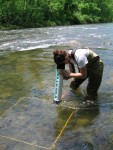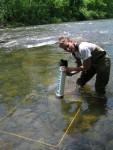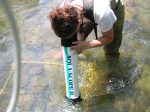You are currently browsing the category archive for the ‘Week 2’ category.
This week I helped sample fish at two sites on the Middle River and helped survey the Jackson River for Didymo, an invasive algae.
Topics
- Middle River Sampling
- Didymo Surveys
- Some Thoughts
Middle River Sampling
This week I helped sample the Middle River at two different sites, one in Port Republic and one near Verona. This sampling was carried out with the South River Science team and was part of their ongoing Mercury study. This week we used an electro-shocking boat and barge to sample the fish. The Middle River was being sampled as a control river, since it has not been contaminated by Mercury.
Didymo Surveys
Why Didymo / What Is It?
Didymo is an invasive species of algae. When it first appeared in the Jackson River scientists were afraid that it might negatively affect the aquatic insect population and hurt fish populations, since fish prey on aquatic insects. Luckily, the aquatic insects and fish have not suffered, but the algae is still being monitored since it is invasive.
How We Sampled
For this survey I helped DGIF and U.S. Forest Service staff to sample at three sites, one just below the dam at Lake Moomaw and then two more downstream. To quantify the amount of algae in the river at each site, we set up a transect across the river and then placed a large square metal frame on the bottom of the river every two meters. The square metal frame was divided into quadrants by string, and then viewing scopes were used to view the algae underwater. The coverage of algae in each quadrant was then ranked 0, 1, 2, or 3 with 0 representing 0% coverage, 1 representing 1-35% coverage, 2 representing 36-70% coverage, and 3 representing 71%-100% coverage.
What We Found
The algae was most abundant at the site closest to the dam and quadrants often received scores of 3 or 4. At the two downstream sites the Didymo was less prevalent, and numbers of 0, 1, and 2 were more common. I learned that Didymo prefers cold water and stable substrate like rocks, roots, or sticks.
Some Thoughts
One of the most interesting parts of the week for me was getting to talk with a U.S. Forest Service biologist when I was helping survey the Didymo. She has been involved in surveying Didymo because the Jackson River runs through national forest land.
Because I am interested in public involvement and decision-making she told me about the process of creating a plan for the national forest. Creating the comprehensive plan, which takes place every 10 years or so, is extremely important because every decision relates back to this master plan. Many people have different ideas about what national forest, specifically the George Washington and Jefferson forests, should be used for and how or if they should be developed. Timber harvest, old growth management, biking and hiking trails, historic sites, and animal habitat are just a few of the issues which are discussed and planned for. It was really interesting to learn how the public and different interests groups as well as U.S. Forest Service staff come together to make decisions about how to manage these resources.
This week I helped sample fish at two sites on the Middle River and helped survey the Jackson River for Didymo, an invasive algae.
Topics
· Middle River Sampling
· Didymo Surveys
· Some Thoughts
Middle River Sampling
This week I helped sample the Middle River at two different sites, one in Port Republic and one near Verona. This sampling was carried out with the South River Science team and was part of their ongoing Mercury study. This week we used an electro-shocking boat and barge to sample the fish. The Middle River was being sampled as a control river, since it has not been contaminated by Mercury.
Didymo Surveys
Why Didymo / What Is It?
Didymo is an invasive species of algae. When it first appeared in the Jackson River scientists were afraid that it might negatively affect the aquatic insect population and hurt fish populations, since fish prey on aquatic insects. Luckily, the aquatic insects and fish have not suffered, but the algae is still being monitored since it is invasive.
How We Sampled
For this survey I helped DGIF and U.S. Forest Service staff to sample at three sites, one just below the dam at Lake Moomaw and then two more downstream. To quantify the amount of algae in the river at each site, we set up a transect across the river and then placed a large square metal frame on the bottom of the river every two meters. The square metal frame was divided into quadrants by string, and then viewing scopes were used to view the algae underwater. The coverage of algae in each quadrant was then ranked 0, 1, 2, or 3 with 0 representing 0% coverage, 1 representing 1-35% coverage, 2 representing 36-70% coverage, and 3 representing 71%-100% coverage.
What We Found
The algae was most abundant at the site closest to the dam and quadrants often received scores of 3 or 4. At the two downstream sites the Didymo was less prevalent, and numbers of 0, 1, and 2 were more common. I learned that Didymo prefers cold water and stable substrate like rocks, roots, or sticks.
Some Thoughts
One of the most interesting parts of the week for me was getting to talk with a U.S. Forest Service biologist when I was helping survey the Didymo. She has been involved in surveying Didymo because the Jackson River runs through national forest land.
Because I am interested in public involvement and decision-making she told me about the process of creating a plan for the national forest. Creating the comprehensive plan, which takes place every 10 years or so, is extremely important because every decision relates back to this master plan. Many people have different ideas about what national forest, specifically the George Washington and Jefferson forests, should be used for and how or if they should be developed. Timber harvest, old growth management, biking and hiking trails, historic sites, and animal habitat are just a few of the issues which are discussed and planned for. It was really interesting to learn how the public and different interests groups as well as U.S. Forest Service staff come together to make decisions about how to manage these resources.




